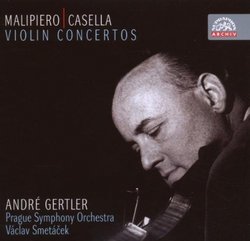| All Artists: Gian Francesco Malipiero, Alfredo Casella, Vaclav Smetacek, Prague Symphony Orchestra Title: Malipiero: Violin Concerto; Casella: Violin Concerto Members Wishing: 0 Total Copies: 0 Label: Supraphon Original Release Date: 1/1/2007 Re-Release Date: 4/24/2007 Album Type: Import Genre: Classical Styles: Forms & Genres, Concertos, Symphonies Number of Discs: 1 SwapaCD Credits: 1 UPC: 099925390426 |
Search - Gian Francesco Malipiero, Alfredo Casella, Vaclav Smetacek :: Malipiero: Violin Concerto; Casella: Violin Concerto
 | Gian Francesco Malipiero, Alfredo Casella, Vaclav Smetacek Malipiero: Violin Concerto; Casella: Violin Concerto Genre: Classical |
Larger Image |
CD Details |
CD ReviewsTwo enjoyable works, stylistically close, surprisingly lyric Discophage | France | 07/29/2007 (4 out of 5 stars) "André Gertler (1907-1998), now a rather forgotten figure, was an important Hungarian violinist, established in Belgium since 1928 and active mostly from the thirties to the early seventies. He was noted by an LP-nurtured generation of music lovers for his recording of the complete output for violin written by his compatriot and close friend Bartok, recorded in 1965 by the Czech firm Supraphon, including the duets with Josef Suk, the complete violin and piano works with Diane Andersen, the concertos and rhapsodies with Karel Ancerl and Janos Ferencsik. They were elegant readings, sometimes lacking in sheer raw power. Not all of them have been reissued on CD, and some of these reissues (as the duets, published in the early days of the CD by an obscure label called Sound) are now near impossible to find. In 1954 he also made one of the earliest recordings of Berg's Violin Concerto and of Bartok's Solo Violin Sonata for EMI (now reissued on CD by Hungaroton: Bach/Bartók/Berg: Concertos & Sonata for Violin) - he had given the European Premiere of the latter. Gertler's recordings also included even rarer 20th century repertoire, such as the Violin Concertos of Hartmann and Hindemith (both now on Hindemith: Concerto for violin; Cello Concerto) and Matyas Seiber's Fantasia Concertante. Supraphon reissued his 1962 recording of Enescu's magnificent 3rd Violin and Piano Sonata and Milhaud's lightweight and sunny 2nd, aptly coupled with a later (1971) recording of Milhaud's 2nd Violin Concerto (see my reviews of Andre Gertler performs Milhaud Violin Concert No 2, Violin Sonata No 2; Enescu Violin Sonata No 3 (Supraphon) or Milhaud & Enescu: Concerto for Violin /Sonata for Violin Import).
On the original LP the Milhaud Concerto was paired with Gian Francesco Malipiero's 1st Violin Concerto from 1932, which Supraphon has now aptly reissued with the 1928 Violin Concerto op. 48 of Malipiero's contemporary and fellow Italian Alfredo Casella; the latter piece was recorded in 1974 and on the original LP (released only in 1977) came with Seiber's Fantasia Concertante. Given the close personal ties between both composers (in 1923, in company of the poet Gabriele d'Annunzio, they founded the "Corporation of New Music", an association aimed at spreading modern Italian music) and stylistic similarities between the two compositions, it is hard to imagine that this was not the original pairing. It is also hard to imagine today that in the 1920s and `30s Malipiero (1882-1973) and Casella (1883-1947) were considered among the major modern composers of their days (and so was Milhaud). Evidently they were at some point overpassed by the development of music history and compositional styles, and their respective Violin Concerto give a clue as to why. They are surprisingly Romantic and lyrical works, Malipiero at times sounding like Milhaud at the Provence composer's most sunny, and Casella with more dramatic passages, with a rhythmic bite and orchestral grandeur at times evocative of Hindemith (try the first movement at 1:53 or later around 6'). More generally both works sound like the kind of Violin Concerto some of the major American composers might have written in the late 30s to early 50s - one thinks of Barber or Piston. Special highlights in both works are their lengthy cadenzas: at 7:05 in the first movement of Casella's and again at 9:32 at the end of the 2nd, leading to the 3rd movement, and at 2:13 in the last movement of Malipiero's. Malipiero's Concerto is also notable for the delicate, neo-classical counterpoint writing for woodwind and brass in its first movement, and the meditative mood of its 2nd, reminiscent of Nielsen or Villa Lobos. Casella also has a balletic finale with sardonic trumpets, which brings to mind the kind of music Milhaud or Sauguet might have written in those years In sum, these are hardly major additions to the 20th century literature in the genre and their rarity on disc and in live performance is not entirely unwarranted, but they make for an interesting and endearing jaunt off the beaten track, well worth a visit. At 53:26 minutes though, the disc stands at the inferior limit of what is acceptable on a CD. Seiber's 17' Fantasia Concertante, the original Casella vinyl-mate, could and should have been added. " |
